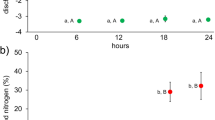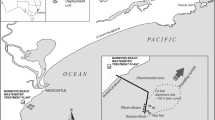Abstract
We used a simulated gizzard environment to examine the bioavailability of barium, cadmium, nobreak copper, lead and zinc to wild and sentinel mallards (Anas platyrhynchos) using a seasonally-flooded wetland. This impoundment was originally constructed as a containment area for dredged sediments which were contaminated through previous smelting operations. Extraction of elements from gizzard contents indicated that sentinel mallards experienced greater exposure to contaminants than their wild counterparts. Concentrations of the selected elements extracted from ingesta were lower than in seeds and sediments from the study site. Notable exceptions were barium and lead, which were not detected in seeds of some plant species, though they were present in the ingesta of one or more treatment groups. This technique may provide a more realistic means of estimating bioavailability and exposure than methods which measure total concentrations of elements in dietary components. The use of sentinel mallards may result in inflated estimates of risk to wild ducks using seasonally-available wetlands.
Similar content being viewed by others
References
Becker, W.M. and Hoekstra, W.G. (1971). The intestinal absorption of zinc. In S.C. Skoryna and D. Waldron-Edward (eds) Intestinal Absorption of Metal Ions, Trace Elements, and Radionuclides, pp. 229–56. Oxford: Pergamon Press.
Beyer, W.N., Blus, L.J., Henny, C.J. and Audet, D. (1997). The role of sediment ingestion in exposing wood ducks to lead. Ecotoxicology 6, 181–6.
Beyer, W.N., Connor, E.E. and Gerould, S. (1994). Estimates of soil ingestion by wildlife. J. Wildl. Manage. 58, 375–82.
Blus, L.J., Henny, C.J., Hoffman, D.J. and Grove, R.A. (1993). Accumulation and effects of lead and cadmium on wood ducks near a mining and smelting complex in Idaho. Ecotoxicology 2, 139–54.
Blus, L.J., Henny, C.J., Hoffman, D.J. and Grove, R.A. (1991). Lead toxicosis in tundra swans near a mining and smelting complex in northern Idaho. Arch. Environ. Contam. Toxicol. 21, 549–55.
Borovansky, J. and Riley, P.A. (1989). Cytotoxicity of zinc in vitro. Chem.-Biol. Inter. 69, 279–91.
Chupp, N.R. and Dalke, P.O. (1964). Waterfowl mortality in the Coeur d'Alene River Valley, Idaho. J. Wildl. Manage. 28, 692–702.
Clark, R.G. and Gentle, G.C. (1990) Estimates of grain passage time in captive mallards. Can. J. Zool. 68, 2275–9.
Clark, R.G., Greenwood, H. and Sugden, L.G. (1986). Preliminary estimates of rate of grain passage through the digestive tract of mallards. Can. Wildl. Serv. Prog. Notes No. 160, 2 pp.
Custer, T.W., Sparks, D.W., Sobiech, S.A., Mines, R.K. and Melancon, M.J. (1996). Organochlorine accumulation by sentinel mallards at theWinston-Thomas sewage treatment plant, Bloomington, Indiana. Arch. Environ. Contam. Toxicol. 30, 163–9.
Drake, S.O., Jr. (1970).Winter foods of mallards of Eufala National Wildlife Refuge. M.S. Thesis, Auburn, AL, 117 pp.
Eisler, R. (1988) Lead hazards to fish, wildlife, and invertebrates: A syntopic review. U.S. Fish Wildl. Serv. Biol. Rpt. 85(1.14), Contam. Haz. Rev. Rpt. 14
Friberg, L., Piscator, M., Nordberg, G.F. and Kjellstrom, T. (1974). Cadmium in the Environment. Cleveland: CRC Press.
Havera, S.P. 1999. Waterfowl of Illinois: Status and Management, 628 pp. IL Nat. Hist. Sur. Spec. Publ. 21.
Jordan, J.S. (1968). Influence of diet in lead poisoning in waterfowl. Trans. NE Fish Wildl. Conf. 25, 143–70.
Kimball, W.H. and Munir, Z.A. (1971). The corrosion of lead in a simulated waterfowl gizzard. J. Wildl. Manage.35, 360–5.
Malone, C.R. (1965). Dispersal of plankton: rate of food passage in mallard ducks. J. Wildl. Manage. 29, 529–33.
Sanderson, G.C. and Bellrose, F.C. (1986). A review of the problem of lead poisoning in waterfowl. IL Nat. Hist. Surv. Spec. Publ. 4.
Society of Environmental Toxicology and Chemistry. (1987). Research priorities in environmental risk assessment.Workshop Report. Society of Environmental Toxicology and Chemistry, Pensacola, FL. 103 pp.
Suzuki, S., Tetsuya, T. and Yokohashi, G. (1969). Dietary factors influencing upon the retention rate of orally administered 115mCdCl2in mice. Ind. Health 7, 155–62.
Trost, R.E. (1981). Dynamics of grit selection and retention in captive mallards. J. Wildl. Manage. 45, 64–73.
Underwood, E.J. (1971). Trace Elements in Human and Animal Nutrition, 543 pp. New York and London: Academic Press.
USEPA (1994). Method 200.7, Revision 4.4, Determination of metals and trace elements in water and wastes by inductively coupled plasma-atomic emission spectroscopy. Methods for the Determination of Metals in Environmental Samples, Supplement I, EPA-600/R-94-111
Vermeer, K. and Peakall, D.B. (1979). Trace metals in seaducks of the Fraser River Delta Intertidal Area, British Columbia. Marine Pollut. Bull. 10, 189–92.
Washko, P.W. and Cousins, R.J. (1977). Role of dietary calcium and calcium binding protein in cadmium toxicity in rats. J. Nutr. 107, 920–8.
Weseloh, D.V.C., Struger, J. and Hebert, C. (1994). White Pekin ducks (Anas platyrhynchos) as monitors of organochlorine and metal contamination in the Great Lakes. Assoc. Great Lakes Res. 20, 277–88.
Zar, J.H. (1984). Biostatistical Analysis, 718 pp. Englewood Cliffs, NJ: Prentice-Hall, Inc.
Author information
Authors and Affiliations
Corresponding author
Additional information
An erratum to this article can be found at http://dx.doi.org/10.1023/A:1016846920652
Rights and permissions
About this article
Cite this article
Levengood, J.M., Skowron, L.A. Use of a simulated gizzard to measure bioavailability of metals and other elements to waterfowl. Ecotoxicology 10, 299–304 (2001). https://doi.org/10.1023/A:1016763418647
Issue Date:
DOI: https://doi.org/10.1023/A:1016763418647




